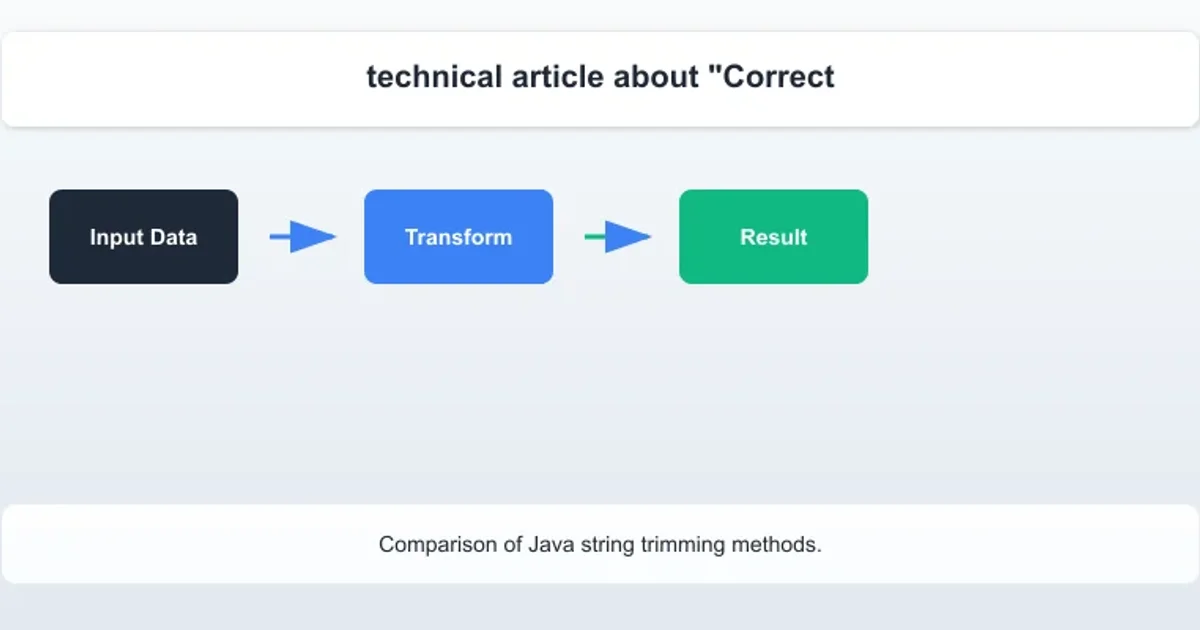Correct way to trim a string in Java
Categories:
Mastering String Trimming in Java: A Comprehensive Guide

Learn the correct and efficient ways to remove leading, trailing, and all whitespace from strings in Java, including common pitfalls and best practices.
String manipulation is a fundamental task in programming, and trimming whitespace is one of the most common operations. In Java, several methods are available to achieve this, each with slightly different behaviors and use cases. This article will explore the standard trim(), strip(), stripLeading(), stripTrailing(), and regular expression-based approaches, helping you choose the right tool for your specific needs.
Understanding Java's Built-in Trimming Methods
Java provides convenient methods directly on the String class for trimming whitespace. It's crucial to understand their differences, especially between older and newer versions of Java, to ensure your code behaves as expected across different environments.
String objects in Java are immutable. All trimming methods return a new string with the whitespace removed, rather than modifying the original string in place. You must assign the result back to a variable if you want to use the trimmed string.trim(): The Classic Approach
The trim() method has been a staple since Java 1.0. It removes leading and trailing whitespace characters whose ASCII value is less than or equal to U+0020 (the space character). This includes common characters like space, tab (\t), newline (\n), and carriage return (\r). However, it does not handle all Unicode whitespace characters.
String textWithSpaces = " Hello World! \t\n";
String trimmedText = textWithSpaces.trim();
System.out.println("Original: '" + textWithSpaces + "'");
System.out.println("Trimmed: '" + trimmedText + "'");
Using the trim() method to remove leading and trailing ASCII whitespace.
strip(), stripLeading(), stripTrailing(): Modern Unicode-Aware Trimming
Introduced in Java 11, the strip(), stripLeading(), and stripTrailing() methods offer a more robust solution for handling whitespace. Unlike trim(), these methods use Character.isWhitespace(char) to determine what constitutes whitespace. This means they correctly identify and remove all Unicode whitespace characters, not just those with ASCII values less than or equal to U+0020.
String unicodeText = "\u2005\u3000Hello Unicode!\u2005\u3000"; // \u2005 is Four-Per-Em Space, \u3000 is Ideographic Space
System.out.println("Original: '" + unicodeText + "'");
String strippedText = unicodeText.strip();
System.out.println("Stripped: '" + strippedText + "'");
String strippedLeading = unicodeText.stripLeading();
System.out.println("StripLeading: '" + strippedLeading + "\u2005\u3000'"); // Trailing spaces remain
String strippedTrailing = unicodeText.stripTrailing();
System.out.println("StripTrailing: '\u2005\u3000" + strippedTrailing + "'"); // Leading spaces remain
Demonstrating strip(), stripLeading(), and stripTrailing() with Unicode whitespace.
flowchart TD
A[Input String] --> B{Java Version < 11?}
B -- Yes --> C[Use `trim()`]
B -- No --> D{Need Unicode-aware trimming?}
D -- Yes --> E[Use `strip()`]
D -- No --> C
C --> F[Removes ASCII <= U+0020]
E --> G[Removes all `Character.isWhitespace()`]
F --> H[Output String]
G --> HDecision flow for choosing between trim() and strip().
Removing All Whitespace (Including Internal)
Sometimes, you might need to remove all whitespace characters from a string, not just leading and trailing ones. This is a common requirement for tasks like parsing user input, sanitizing data, or preparing strings for specific formats. Regular expressions are the most flexible and powerful way to achieve this.
String textWithInternalSpaces = " Hello World! How are you? ";
// Remove all whitespace characters
String noSpaces = textWithInternalSpaces.replaceAll("\\s", "");
System.out.println("Original: '" + textWithInternalSpaces + "'");
System.out.println("No internal spaces: '" + noSpaces + "'");
// Replace multiple spaces with a single space (and then trim)
String singleSpaces = textWithInternalSpaces.replaceAll("\\s+", " ").trim();
System.out.println("Single spaces: '" + singleSpaces + "'");
Using replaceAll() with regular expressions to remove all or normalize internal whitespace.
\s matches any whitespace character (space, tab, newline, carriage return, form feed, etc.). \s+ matches one or more whitespace characters. Using replaceAll("\\s", "") is highly effective for complete whitespace removal.Performance Considerations
For most applications, the performance difference between trim() and strip() is negligible. However, when dealing with extremely large strings or performing trimming operations millions of times, it's worth noting that trim() might be marginally faster due to its simpler character check. replaceAll() with regular expressions will generally be slower than the direct trim() or strip() methods due to the overhead of regex engine processing, but it offers unmatched flexibility for complex patterns.

Comparison of Java string trimming methods.